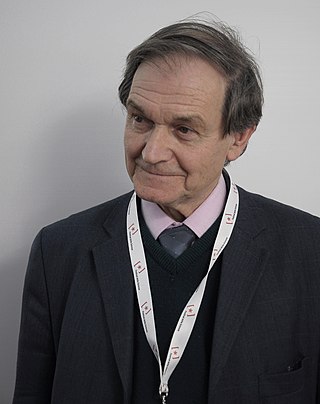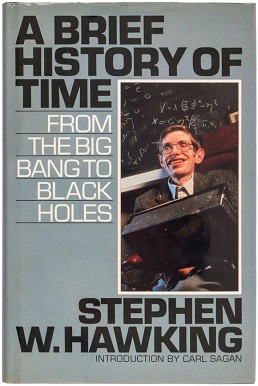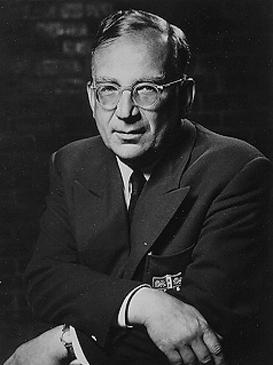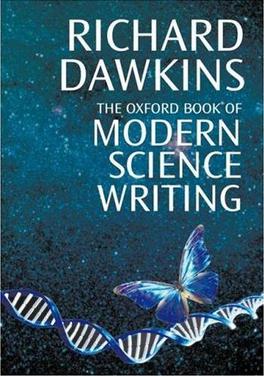Related Research Articles

The Big Bang is a physical theory that describes how the universe expanded from an initial state of high density and temperature. The Big Bang theory was inspired by the discovery of the expanding Universe by Edwin Hubble. It was first proposed in 1927 by Roman Catholic priest and physicist Georges Lemaître. Lemaître reasoned that if we go back in time, there must be fewer and fewer matter, until all the energy of the universe is packed in a unique quantum. Various cosmological models of the Big Bang explain the evolution of the observable universe from the earliest known periods through its subsequent large-scale form. These models offer a comprehensive explanation for a broad range of observed phenomena, including the abundance of light elements, the cosmic microwave background (CMB) radiation, and large-scale structure. The overall uniformity of the universe, known as the flatness problem, is explained through cosmic inflation: a sudden and very rapid expansion of space during the earliest moments. However, physics currently lacks a widely accepted theory of quantum gravity that can successfully model the earliest conditions of the Big Bang.

Francis Harry Compton Crick was an English molecular biologist, biophysicist, and neuroscientist. He, James Watson, Rosalind Franklin, and Maurice Wilkins played crucial roles in deciphering the helical structure of the DNA molecule.

General relativity, also known as the general theory of relativity and Einstein's theory of gravity, is the geometric theory of gravitation published by Albert Einstein in 1915 and is the current description of gravitation in modern physics. General relativity generalizes special relativity and refines Newton's law of universal gravitation, providing a unified description of gravity as a geometric property of space and time or four-dimensional spacetime. In particular, the curvature of spacetime is directly related to the energy and momentum of whatever matter and radiation are present. The relation is specified by the Einstein field equations, a system of second order partial differential equations.

Physics is a branch of science whose primary objects of study are matter and energy. Discoveries of physics find applications throughout the natural sciences and in technology. Historically, physics emerged from the scientific revolution of the 17th century, grew rapidly in the 19th century, then was transformed by a series of discoveries in the 20th century. Physics today may be divided loosely into classical physics and modern physics.

Physics is the natural science of matter, involving the study of matter, its fundamental constituents, its motion and behavior through space and time, and the related entities of energy and force. Physics is one of the most fundamental scientific disciplines, with its main goal being to understand how the universe behaves. A scientist who specializes in the field of physics is called a physicist.

Sir Roger Penrose is a British mathematician, mathematical physicist, philosopher of science and Nobel Laureate in Physics. He is Emeritus Rouse Ball Professor of Mathematics in the University of Oxford, an emeritus fellow of Wadham College, Oxford, and an honorary fellow of St John's College, Cambridge, and University College London.

A Brief History of Time: From the Big Bang to Black Holes is a book on theoretical cosmology by English physicist Stephen Hawking. It was first published in 1988. Hawking wrote the book for readers who had no prior knowledge of physics.

George Gamow, sometimes Gammoff; born Georgiy Antonovich Gamov was a Soviet and American polymath, theoretical physicist and cosmologist. He was an early advocate and developer of Lemaître's Big Bang theory. Gamow discovered a theoretical explanation of alpha decay by quantum tunneling, invented the liquid drop model and the first mathematical model of the atomic nucleus, worked on radioactive decay, star formation, stellar nucleosynthesis, Big Bang nucleosynthesis, and molecular genetics.
In philosophy, philosophy of physics deals with conceptual and interpretational issues in modern physics, many of which overlap with research done by certain kinds of theoretical physicists. Philosophy of physics can be broadly divided into three areas:

Sir John Douglas Cockcroft was a British physicist who shared with Ernest Walton the Nobel Prize in Physics in 1951 for splitting the atomic nucleus, and was instrumental in the development of nuclear power.

VictorFrederick "Viki" Weisskopf was an Austrian-born American theoretical physicist. He did postdoctoral work with Werner Heisenberg, Erwin Schrödinger, Wolfgang Pauli, and Niels Bohr. During World War II he was Deputy Division Leader of the Theoretical Division of the Manhattan Project at Los Alamos, and he later campaigned against the proliferation of nuclear weapons.

A physical paradox is an apparent contradiction in physical descriptions of the universe. While many physical paradoxes have accepted resolutions, others defy resolution and may indicate flaws in theory. In physics as in all of science, contradictions and paradoxes are generally assumed to be artifacts of error and incompleteness because reality is assumed to be completely consistent, although this is itself a philosophical assumption. When, as in fields such as quantum physics and relativity theory, existing assumptions about reality have been shown to break down, this has usually been dealt with by changing our understanding of reality to a new one which remains self-consistent in the presence of the new evidence.
John Tyler Bonner was an American biologist who was a professor in the Department of Ecology and Evolutionary Biology at Princeton University. He was a pioneer in the use of cellular slime molds to understand evolution and development over a career of 40 years and was one of the world's leading experts on cellular slime moulds. Arizona State University says that the establishment and growth of developmental-evolutionary biology owes a great debt to the work of Bonner's studies. His work is highly readable and unusually clearly written and his contributions have made many complicated ideas of biology accessible to a wide audience.

Lillian Rosanoff Lieber was a Russian-American mathematician and popular author. She often teamed up with her illustrator husband, Hugh Gray Lieber, to produce works.
Events from the year 1865 in the United Kingdom.

The Oxford Book of Modern Science Writing is an anthology of scientific writings, arranged and introduced by Richard Dawkins of the University of Oxford. Published first in March 2008, it contains 83 writings on many topics from a diverse variety of authors, which range in length from one to eight pages. All inclusions are dated post-1900, and include poetry, anecdotes, and general philosophical musings.
The RNA Tie Club was an informal scientific club, meant partly to be humorous, of select scientists who were interested in how proteins were synthesised from genes, specifically the genetic code. It was created by George Gamow upon a suggestion by James Watson in 1954 when the relationship between nucleic acids and amino acids in genetic information was unknown. The club consisted of 20 full members, each representing an amino acid, and four honorary members, representing the four nucleotides. The function of the club members was to think up possible solutions and share with the other members.

One Two Three... Infinity: Facts and Speculations of Science is a popular science book by theoretical physicist George Gamow, first published in 1947, but still available in print and electronic formats. The book explores a wide range of fundamental concepts in mathematics and science, written at a level understandable by middle school students up through "intelligent layman" adults. The book includes many handmade illustrations by Gamow.
Martynas Yčas was a Lithuanian-born microbiologist. He co-authored the book Mr. Tompkins: Inside Himself with physicist George Gamow.
References
- George Gamow, Mr Tompkins in Wonderland, first published in 1939
- George Gamow, Mr Tompkins explores the atom, first published in 1944
- George Gamow, Mr Tompkins learns the facts of life, Cambridge University Press, 1953
- George Gamow and Martynas Ycas, Mr Tompkins inside himself: Adventures in the new biology, Viking Press, 1967
- George Gamow, Roger Penrose (Foreword), Mr Tompkins in Paperback (Omnibus of Mr Tompkins in Wonderland and Mr Tompkins Explores the Atom), Cambridge University Press, 1993, ISBN 0-521-44771-2
- George Gamow, Russell Stannard (Editor), Michael Edwards (Illustrator), The New World of Mr Tompkins, Cambridge University Press, 2001 (revised and updated edition), ISBN 0-521-63992-1
- Igor Gamow (Writer), Scorpio Steele (Illustrator), The Adventures of Mr. Tompkins, CreateSpace, 2010 ISBN 1-4392-5211-4
- Igor Gamow (Writer), Scorpio Steele (Illustrator), The Adventures of Mr. Tompkins, No. 2, CreateSpace, 2011 ISBN 1-4611-9559-4